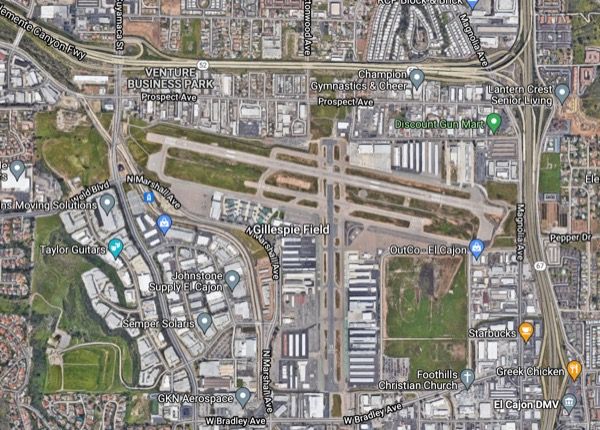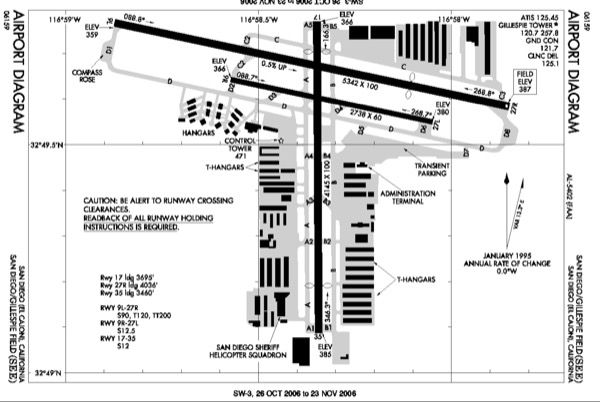Plane crash near San Diego
-
https://nypost.com/2021/12/28/small-plane-crashes-in-neighborhood-near-san-diego/
A private jet crashed Monday night near San Diego, seconds after the pilot was heard screaming, “Oh s–t! Oh s–t!” in air-traffic control audio — leaving a fiery wreckage on a suburban street and knocking out power to hundreds of homes, according to authorities and reports.
The Learjet 35A, a twin-engine business jet that seats up to eight, disintegrated on impact after crashing in the Bostonia area of El Cajon shortly after 7 p.m. Monday, the Times of San Diego reported.
No survivors have been reported.
Audio posted by the news outlet captured the final minute of the doomed flight as the air-traffic controller clears the pilot to land on Runway 17.
The pilot then informs the tower that he wanted to switch to visual flight rules and asked for permission to land on Runway 27 instead.
“IFR (Instrument Flight Rules) cancellation received. You can overfly the field, make left traffic, Runway 27 Right, Runway 27 Right, clear to land,” the controller says.
But something then goes horribly wrong as the plane prepares to land at Gillespie Field in rainy conditions.
“Oh, s—! Oh s—!” the pilot is heard screaming in the gut-wrenching audio.
-
Coming from the north headed for runway 17, left traffic (making left turns)
He changes to 27 right and will overfly the field
So he flies over the field, heading from the north to south, and intends to make 3 left turns
I wonder if he got himself lined up to land on the highway and then hit power lines
That is just a total guess, but I could imagine it happening on a dark and stormy night
I'm just guessing based on looking at those pictures
-
It looks like he got low and slow, turned too steeply and stalled the left wing while making a left turn toward the runway. After that there was no hope. He probably lost sight of the runway and when he saw it again he probably tried to turn too tightly and it was too late.
If you are going to make that mistake, that is exactly the wrong place to do it. I knew a guy who did it, West Point grad, sharp guy made a dumb mistake he killed himself and the airplane owner's girl friend.
Doorbell camera video shows the airplane, the smoke from the crash
Link to videoLink to videoI notice he asked for the lights to be turned up, they were already at 100%
Audio with ATC:
Link to videoSimulation
Link to videoLink to video -
@george-k Rwy 17 is 4145 feet long
Rwy 27R is 5342 feet long
I don't know what the wind was doing, and I don't know the landing performance of the Lear 35.
But, 5,000+ feet is pretty standard for jet runways, although many can operate on shorter runways depending on the conditions.
He might have wanted the extra distance for safety.
That kind of circle-to-land approach can be common. He could use the approach to 17 to find the field then turn to land on runway 27R.
Circle-to-land can be tricky on a dark, rainy approach because it requires the pilot to navigate by looking out the window. If he looses sight of the runway, even briefly, he is supposed to immediately climb and fly the missed approach. It is easy to lose sight of the runway and the temptation is to try to find it visually - bad idea. This might have happened, he might have lost the runway, then spotted the runway and lost control trying to make a tight turn toward it.
All this is, of course, practiced by students and instructors. If I was with a student flying a circle-to-land approach there is a good chance I would say "you just lost sight of the field". Then make sure they climb immediately.
-
A friend of mine knew the victims of the crash, and in fact had a neighboring hanger. What he posted on FB:
DEATH OF A NEIGHBOR
My office, such as it is, is attached to the aircraft hangar I own at Gillespie Field airport in El Cajon, a suburb to the east of San Diego. The next-door hangar is owned by the Grande family.
The family's patriarch, Bob, founded a machining company more than forty years ago. It employs nearly a hundred people now and is located a few minutes from the airport. When he purchased the hangar some years back, I saw Bob occasionally, but after a while it was his sons who began to make use of the place.
For I suppose a couple of years Tom has been living upstairs. I see him going to and coming from work at his father's company. The ground floor of the hangar is filled with not just a plane but with a boat and other "toys" that are popular with outdoor enthusiasts.
I often see Tom and his young son and daughter. It might have been Monday when I last saw the kids, sitting in a car in the parking lot, and joshed with them about their stuffed-animal Christmas presents.
Before Tom moved in, his brother Doug frequented the hangar. A guy with an invariable smile, Doug flew frequently, and I always enjoyed chatting with him, but once Tom had need of the hangar, Doug didn't come around as often. It had been months since I last saw him drop by.
Last Monday night came news of an airplane crash less than two miles from the airport. The plane nosed down onto a residential street, missing houses but being utterly destroyed itself. It took several days for facts about the crash to become collected.
First it was made known that the plane was a Learjet. Its short flight--less than 20 minutes--had originated at John Wayne Airport in Orange County. The plane was said to have belonged to an air ambulance service based at Gillespie Field.
When I first learned that, I didn't make a connection. I didn't think someone I knew might be involved.
At that point it wasn't clear whether only the pilot was on board or whether others were on the plane too. I think it was yesterday that it was revealed that there had been two pilots and two nurses, all of whom perished in the crash.
Then this morning I read that Doug Grande had been one of the pilots. As I write this, I'm glancing out the window, hoping to see Tom as he walks to his pickup so I can convey my condolences.
. . . . .
Monday night was wet. The ceiling was low over Gillespie Field. The Learjet had been on an instrument approach to Runway 17, which faces almost due south. After descending from the clouds the pilot canceled his IFR (instrument flight rules) approach, went to VFR (visual flight rules), and prepared to use the perpendicular runway, 27 Right, which heads almost due west.
The change likely was because Runway 17 was too short for a Learjet, which, coming in fairly fast, needs a long roll out. Runway 27R is about 1,000 feet longer.
The plane passed above Runway 17 and then turned left, on the far side of Runway 27R, for the downwind leg. Passing the field, it then began to turn onto the base leg, after which would come the turn onto final.
It never got that far. It went down on the turn to base--probably a classic stall/spin accident.
When we say a car stalls, we mean the engine quits. That's not what a stall is in aviation. In flying terms, a stall has nothing to do with the engine. It has to do with lift generated by the wings. When a plane's "angle of attack" is high (that is, its nose is pulled up steeply), the wings generate less lift.
When the yoke or stick is pulled back far enough, the lift goes to zero. At altitude this isn't a problem, though it's momentarily unnerving. The nose of the plane drops abruptly, and the wings regain lift. The pilot pulls back on the controls, and the plane resumes normal flight. Every flight student gets training in doing and recovering from stalls.
But in a turn, a stall can be deadly. The nose doesn't just drop. The plane goes into a spiral, and it's difficult to recover from a spiral unless one is well above the ground, since a spiral eats up lots of altitude quickly.
If the plane is near the ground--say, less than 1,500 feet or so, recovery may be impossible. It appears that this Learjet was only about 400 feet above the ground, less than half of what it should have been at that point in its approach to Runway 27R.
Why could this have happened, with two experienced pilots on board, pilots who knew Gillespie Field and its approach patterns? It's hard to say. It might have been the visual distortion that comes from a light mist covering the airport. Mist has a way of making things--including the ground--look farther away than they are.
They might have thought initially that they were farther from the airport than they really were but then realized how close they were and so made a steeper than normal turn in order to prepare for the turn to final. At low speeds steep turns can result in stalls, since lift is reduced in turns.
The National Transportation Safety Board already is investigating the crash. Its final report is likely more than a year away, but already people who study airplane crashes have been chiming in, all pretty much in accord: it looks like a stall/spin accident.
In the meantime, the Grande family is in mourning. I didn't know Doug well, but I liked him, and now I grieve for him, his wife and children, and his extended family.
Requiescat in Pace, neighbor. -
Early analysis, not final
Link to video -
Fascinating analysis (I'm about ⅔ through).
He says that the pilot kept airspeed at about 130 knots during the turn, which is supposedly above the stall speed of that model of Lear.
Does that also apply when he's banking? If the aircraft is not level, doesn't lift decrease and a stall-spin is more likely at lower speeds?
-
The plane (wing) can stall at any speed. It's is the angle of attack of the wind relative to the wing that matters.
There are maneuvers that can cause an accelerated stall. An accelerated stall is caused by abrupt or excessive control inputs.
For example, pulling up quickly on the stick or making a steep turn.
Accelerated stalls normally wouldn't be performed by a student pilot, but a few types of accelerated stalls are required maneuvers for a flight instructor.
Although we do talk about "stall speeds", these are for given, mostly straight and level, conditions, not accelerated conditions.
A higher angle of bank definitely increases the stall speed.
So he could have been going over 130 knots but still cause a stall by pulling up and turning abruptly.
-
I just found a Lear 45 Airplane Flight Manual (instruction book), the accident plane was a Lear 35, but I assume it was similar.
Here is the whole AFM https://hangar45.net/wp-content/uploads/2017/10/learjet-45-afm.pdf
Here is the page that answers your question, as the bank angle goes up, the stall speed goes up, follow the dotted line:
 .)
.)I might have mentioned before that I (used to) spend a lot of time reading Airplane Flight Manuals, sometimes known as Pilots Operating Handbook (POH). I used 85 different POHs building one of my Apps. I like reading these things
Here is what Stall Speed definition looks like in a Cessna 182T, 4-seat single prop plane that I used to fly.
Expressed by numbers in a table. A different format than the graph format used in the Lear above.
 image url)
image url)

